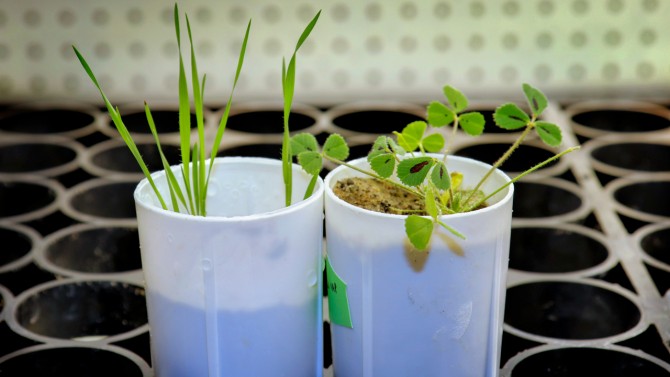Discovery could mitigate fertilizer pollution in waterways
By Aaron J. Bouchie
Excess fertilization of agricultural fields is a huge environmental problem. Phosphorus from fertilized cropland frequently finds its way into rivers and lakes, and the resulting boom of aquatic plant growth can cause oxygen levels in the water to plunge, leading to fish die-offs and other harmful effects.
Researchers from Boyce Thompson Institute have uncovered the function of a pair of plant genes that could help farmers improve phosphate capture, potentially reducing the environmental harm associated with fertilization.
Maria Harrison, the William H. Crocker Professor at BTI and adjunct professor in the School of Integrative Plant Science in Cornell’s College of Agriculture and Life Sciences, is senior author of “A CLE–SUNN Module Regulates Strigolactone Content and Fungal Colonization in Arbuscular Mycorrhiza,” which published Sept. 2 in Nature Plants.
The discovery stems from Harrison’s focus on plants’ symbiotic relationships with arbuscular mycorrhizal (AM) fungi, which colonize plant roots to create an interface through which the plant trades fatty acids for phosphate and nitrogen. The fungi also can help plants recover from stressful conditions, such as periods of drought.
But feeding the AM fungi with fatty acids is costly, so plants don’t let this colonization go unchecked.
To discover how plants control the amount of fungal colonization, Harrison and lead author Lena Müller, a postdoctoral scientist in the Harrison lab, looked at genes that encode short proteins called CLE peptides in the plants Medicago truncatula (barrel clover) and Brachypodium distachyon (purple false brome).
CLE peptides are involved in cellular development and response to stress, and are present in plants ranging from green algae to flowering plants.
The researchers found that two of these CLE genes are key modulators of AM fungal symbiosis. One gene, CLE53, reduces colonization rates once the roots have been colonized. Another gene, CLE33, reduces colonization rates when there is plenty of phosphate available to the plant.
“Being able to control fungal colonization levels in plant roots and maintain the symbiosis even in higher phosphate conditions might be useful to a farmer,” Harrison said. “For example, you may want the other beneficial effects of AM fungi, like nitrogen uptake and recovery from drought, as well as further uptake of phosphate. You might be able to achieve these benefits by altering the levels of these CLE peptides in the plants.”
Müller found that the CLE peptides act through a receptor protein called SUNN. In collaboration with researchers from the University of Amsterdam, she found that the two CLE peptides modulate the plant’s synthesis of a compound called strigolactone.
Plant roots exude strigolactone into the soil, and the compound stimulates AM fungi to grow and colonize the root. Once the roots are colonized, or when there is plenty of phosphate, the CLE genes suppress the synthesis of strigolactone, thus reducing any further colonization by the fungi.
“In the early 2000s, researchers found that plants had a way to measure and then reduce colonization,” Müller said. “But until now, nobody really understood the molecular mechanism of that dynamic.”
The researchers’ next steps will include figuring out the molecules that turn on the CLE genes in response to colonization and high phosphate levels.
Müller also plans to compare the two CLE peptides from this study with additional CLE peptides that have different functions.
“The CLE peptides are all so similar but they have completely different functions,” Müller said. “It will be very interesting to see why that is.”
Other co-authors included Zhangjun Fei, adjunct professor in SIPS and a BTI faculty member; Xuepeng Sun of BTI; and researchers from Clemson University.
The work was supported by grants from the National Science Foundation, the Department of Energy, the Swiss National Science Foundation and the German Research Foundation.
Aaron J. Bouchie is a science writer for Boyce Thompson Institute.
Media Contact
Get Cornell news delivered right to your inbox.
Subscribe

